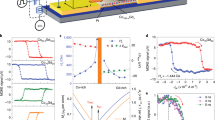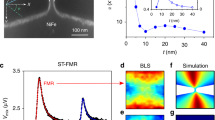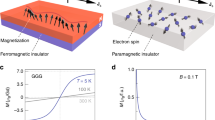Abstract
Spin-relaxation time is key to the performance of spin-based devices1,2. Although the spin-relaxation times of semiconductor materials are typically ∼100 ns (ref. 3), they are on the order of picoseconds in bulk metals due to the high density of scattering centres. In metallic nanoparticles, the spin-relaxation times can be strongly enhanced due to the quantum size effect4,5, reaching 150 ns in cobalt nanoparticles6. Here, we show that for extra electrons confined in a single ferromagnetic-metal MnAs nanoparticle embedded in a GaAs semiconductor matrix, the spin-relaxation time can reach 10 µs at 2 K, which is seven orders of magnitude longer than those of conventional metallic thin film or bulk systems, and the longest value ever reported for metallic nanoparticles. This long relaxation time is made possible by using epitaxially grown single-crystal devices with abrupt interfaces, and by avoiding surface contamination of the MnAs nanoparticle. Such a long spin-relaxation time can be very useful in nanoscale spintronic devices.
This is a preview of subscription content, access via your institution
Access options
Subscribe to this journal
Receive 12 print issues and online access
$259.00 per year
only $21.58 per issue
Buy this article
- Purchase on Springer Link
- Instant access to full article PDF
Prices may be subject to local taxes which are calculated during checkout



Similar content being viewed by others
References
Datta, S. & Das, B. Electronic analog of the electro-optic modulator. Appl. Phys. Lett. 56, 665–667 (1990).
Hai. P. N., Sugahara, S. & Tanaka, M. Reconfigurable logic gates using single-electron spin transistors. Jpn J. Appl. Phys. 46, 6579–6585 (2007).
Dzhioev, R. I. et al. Low-temperature spin relaxation in n-type GaAs. Phys. Rev. B 66, 245204 (2002).
Kawabata, A. Electronic properties of fine metallic particles. III. E.S.R. absorption line shape. J. Phys. Soc. Jpn 29, 902–911 (1970).
Buttet, J., Car, R. & Charles W. M. Size dependence of the conduction-electron-spin- resonance g shift in a small sodium particle: orthogonalized standing-wave calculations. Phys. Rev. B 26, 2414–2431 (1982).
Yakushiji, K. et al. Enhanced spin accumulation and novel magnetotransport in nanoparticles. Nature Mater. 4, 57–61 (2004).
Kwiatkowski, A. et al. Structure and magnetism of MnAs nanocrystals embedded in GaAs as a function of post-growth annealing temperature. J. Appl. Phys. 101, 113912 (2007).
Hai, P. N., Yokoyama, M., Ohya, S. & Tanaka, M. Tunneling magnetoresistance of MnAs thin film/GaAs/AlAs/GaAs:MnAs nanoclusters and its AlAs barrier thickness dependence. Appl. Phys. Lett. 89, 242106 (2006).
Hai, P. N., Takahashi, K., Yokoyama, M., Ohya, S. & Tanaka, M. Magnetic properties of MnAs nanoclusters embedded in a GaAs semiconductor matrix. J. Magn. Magn. Mat. 310, 1932–1934 (2007).
Hai, P. N., Sakata, Y., Yokoyama, M., Ohya, S. & Tanaka, M. Spin-valve effect by ballistic transport in ferromagnetic metal (MnAs)/semiconductor (GaAs) hybrid heterostructures. Phys. Rev. B 77, 214435 (2008).
Panguluri, R. P. et al. Point contact spin spectroscopy of ferromagnetic MnAs epitaxial films. Phys. Rev. B 68, 201307 (2003).
Majumdar, K. & Hershfield, S. Magnetoresistance of the double-tunnel-junction Coulomb blockade with magnetic metals. Phys. Rev. B 57, 11521–11526 (1998).
Barnas, J. & Fert, A. Magnetoresistance oscillations due to charging effects in double ferromagnetic tunnel junctions. Phys. Rev. Lett. 80, 1058–1061 (1998).
Barnas, J. & Fert, A. Effects of spin accumulation on single-electron tunneling in a double ferromagnetic microjunction. Europhys. Lett. 44, 85–90 (1998).
Brataas, A., Nazarov, Yu. V., Inoue, J. & Bauer, G. E. W. Non-equilibrium spin accumulation in ferromagnetic single-electron transistors. Eur. Phys. J. B 9, 421–430 (1999).
Jullière, M. Tunneling between ferromagnetic films. Phys. Lett. A 54, 225–226 (1975).
Ravindran, P. et al. Magnetic, optical and magneto-optical properties of MnX (X=As, Sb, or Bi) from full-potential calculations. Phys. Rev. B 59, 15680–15693 (1999).
Monod, P. & Janossy, A. Conduction electron spin resonance in gold. J. Low Temp. Phys. 26, 311–316 (1977).
Monot, R., Châtelain, A. & Borel, J.-P. Conduction electron spin resonance in small particles of pure gold. Phys. Lett. A 34, 57–58 (1971).
Gustafsson, P., Ohlsén, H. & Nordborg, L. Conduction-electron g-factor measurements in platinum. Phys. Rev. B 33, 3749–3755 (1986).
Gordon, D. A., Marzke, R. F. & Glaunsinger, W. S. Size distribution and ESR of uniform microcrystal of platinum. J. Phys. (Paris) Colloques 38, 87–92 (1977).
Elzerman, J. M. et al. Single-shot read-out of an individual electron spin in a quantum dot. Nature 430, 431–435 (2004).
Kroutvar, M. et al. Optically programmable electron spin memory using semiconductor quantum dots. Nature 432, 81–84 (2004).
De Boeck, J. et al. Nanometer-scale magnetic MnAs particles in GaAs grown by molecular beam epitaxy. Appl. Phys. Lett. 68, 2744–2746 (1996).
Shimizu, H., Miyamura, M. & Tanaka, M. Magneto-optical properties of a GaAs:MnAs hybrid structure sandwiched by GaAs/AlAs distributed Bragg reflectors: enhanced magneto-optical effect and theoretical analysis. Appl. Phys. Lett. 78, 1523–1525 (2001).
Acknowledgements
This work was partly supported by Grant-in-Aids for Scientific Research, the Special Coordination Programs for Promoting Science and Technology, R&D for Next-generation Information Technology by MEXT, PRESTO of JST. P.N.H. acknowledges support from the Global COE program (C04). The authors thank T. Fujii for his help in measurements at Cryogenic Research Centre, and members of the Nakano Laboratory at RCAST, University of Tokyo, for their help in the nanofabrication of our samples.
Author information
Authors and Affiliations
Contributions
P.N.H. designed the experiment, fabricated the samples, collected most of the data and carried out analysis of the data. S.O. provided experimental advice. M.T. planned and managed the research and supervised the experiment. All authors discussed the results and commented on the manuscript.
Corresponding author
Ethics declarations
Competing interests
The authors declare no competing financial interests.
Supplementary information
Supplementary information
Supplementary information (PDF 370 kb)
Rights and permissions
About this article
Cite this article
Hai, P., Ohya, S. & Tanaka, M. Long spin-relaxation time in a single metal nanoparticle. Nature Nanotech 5, 593–596 (2010). https://doi.org/10.1038/nnano.2010.130
Received:
Accepted:
Published:
Issue Date:
DOI: https://doi.org/10.1038/nnano.2010.130
This article is cited by
-
Regulated Ni–Zn–Co ferrites: structural, electrical and magnetic properties tailored by co doping
Journal of Materials Science: Materials in Electronics (2024)
-
Room temperature manipulation of long lifetime spins in metallic-like carbon nanospheres
Nature Communications (2016)
-
Long spin lifetime and large barrier polarisation in single electron transport through a CoFe nanoparticle
Scientific Reports (2016)



